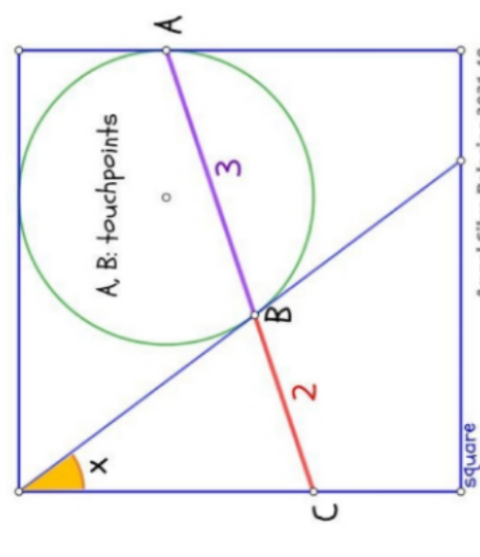
Question Number 176906 by HeferH last updated on 27/Sep/22

Commented by ajfour last updated on 27/Sep/22

Commented by ajfour last updated on 27/Sep/22

$${Let}\:{radius}\:{of}\:{circle}\:{be}\:{r}\:\&\:{side}\:{of} \\ $$$${square}\:{be}\:{a}. \\ $$$${centre}\left({r},\:{a}−{r}\right) \\ $$$${OC}=\sqrt{{r}^{\mathrm{2}} +\left({a}−{r}\right)^{\mathrm{2}} } \\ $$$${y}_{{B}} =\frac{\mathrm{2}\left({a}\right)+\mathrm{3}\left(\mathrm{0}\right)}{\mathrm{5}}=\frac{\mathrm{2}{a}}{\mathrm{5}} \\ $$$${x}_{{C}} ={r}+\mathrm{5sin}\:\alpha \\ $$$${where}\:\:\:\mathrm{cos}\:\alpha=\frac{{a}}{\mathrm{5}} \\ $$$${hence}\:\:{x}_{{C}} ={r}+\sqrt{\mathrm{25}−{a}^{\mathrm{2}} } \\ $$$$\mathrm{sin}\:{x}=\frac{\left(\frac{\mathrm{2}{a}}{\mathrm{5}}\right)}{{a}−{r}} \\ $$$$\mathrm{tan}\:\left(\mathrm{45}°−\frac{{x}}{\mathrm{2}}\right)=\frac{{r}}{{a}−{r}} \\ $$$$\mathrm{1}−\mathrm{tan}\:\frac{{x}}{\mathrm{2}}=\left(\frac{{r}}{{a}−{r}}\right)\left\{\mathrm{1}+\mathrm{tan}\:\frac{{x}}{\mathrm{2}}\right\} \\ $$$$\Rightarrow\:\:\mathrm{tan}\:\frac{{x}}{\mathrm{2}}=\frac{\mathrm{1}−\frac{{r}}{{a}−{r}}}{\mathrm{1}+\frac{{r}}{{a}−{r}}}=\frac{{a}−\mathrm{2}{r}}{{a}} \\ $$$$\Rightarrow\:\:\frac{\left(\frac{\mathrm{2}{a}}{\mathrm{5}}\right)}{{a}−{r}}=\frac{\mathrm{2}\left(\mathrm{1}−\frac{\mathrm{2}{r}}{{a}}\right)}{\mathrm{1}+\left(\mathrm{1}−\frac{\mathrm{2}{r}}{{a}}\right)^{\mathrm{2}} } \\ $$$${say}\:\:\frac{{r}}{{a}}={t}\:\Rightarrow \\ $$$$\mathrm{1}+\left(\mathrm{1}−\mathrm{2}{t}\right)^{\mathrm{2}} =\mathrm{5}\left(\mathrm{1}−{t}\right)\left(\mathrm{1}−\mathrm{2}{t}\right) \\ $$$$\Rightarrow\:\mathrm{2}+\mathrm{4}{t}^{\mathrm{2}} −\mathrm{4}{t}=\mathrm{10}{t}^{\mathrm{2}} −\mathrm{15}{t}+\mathrm{5} \\ $$$$\Rightarrow\:\:\mathrm{6}{t}^{\mathrm{2}} −\mathrm{11}{t}+\mathrm{3}=\mathrm{0} \\ $$$${t}=\frac{\mathrm{11}−\sqrt{\mathrm{121}−\mathrm{72}}}{\mathrm{12}}=\frac{\mathrm{1}}{\mathrm{3}} \\ $$$$\mathrm{sin}\:{x}=\frac{\left(\frac{\mathrm{2}{a}}{\mathrm{5}}\right)}{{a}−{r}}=\frac{\mathrm{2}}{\mathrm{5}\left(\mathrm{1}−{t}\right)} \\ $$$${hence}\:\:\mathrm{sin}\:{x}=\frac{\mathrm{2}}{\mathrm{5}\left(\mathrm{1}−\frac{\mathrm{1}}{\mathrm{3}}\right)}=\frac{\mathrm{3}}{\mathrm{5}} \\ $$$${x}=\mathrm{sin}^{−\mathrm{1}} \frac{\mathrm{3}}{\mathrm{5}}=\mathrm{tan}^{−\mathrm{1}} \frac{\mathrm{3}}{\mathrm{4}} \\ $$
Commented by Tawa11 last updated on 28/Sep/22

$$\mathrm{Great}\:\mathrm{sir}. \\ $$
Answered by mr W last updated on 27/Sep/22

Commented by mr W last updated on 27/Sep/22

$$\mathrm{2}\alpha+{x}=\frac{\pi}{\mathrm{2}} \\ $$$$\Rightarrow\alpha=\frac{\pi}{\mathrm{4}}−\frac{{x}}{\mathrm{2}} \\ $$$$\beta=\frac{{x}}{\mathrm{2}} \\ $$$${r}+\frac{{r}}{\mathrm{tan}\:\alpha}=\left(\mathrm{2}+\mathrm{3}\right)\mathrm{cos}\:\beta \\ $$$$\Rightarrow{r}\left(\mathrm{1}+\frac{\mathrm{1}}{\mathrm{tan}\:\left(\frac{\pi}{\mathrm{4}}−\frac{{x}}{\mathrm{2}}\right)}\right)=\mathrm{5}\:\mathrm{cos}\:\frac{{x}}{\mathrm{2}}\:\:\:...\left({i}\right) \\ $$$${DB}=\frac{{r}}{\mathrm{tan}\:\alpha}=\frac{{r}}{\mathrm{tan}\:\left(\frac{\pi}{\mathrm{4}}−\frac{{x}}{\mathrm{2}}\right)} \\ $$$$\frac{{DB}}{\mathrm{sin}\:\left(\frac{\pi}{\mathrm{2}}−\beta\right)}=\frac{{CB}}{\mathrm{sin}\:{x}} \\ $$$$\frac{{r}}{\mathrm{tan}\:\left(\frac{\pi}{\mathrm{4}}−\frac{{x}}{\mathrm{2}}\right)\:\mathrm{cos}\:\frac{{x}}{\mathrm{2}}}=\frac{\mathrm{2}}{\mathrm{sin}\:{x}} \\ $$$$\Rightarrow\:\frac{{r}}{\mathrm{tan}\:\left(\frac{\pi}{\mathrm{4}}−\frac{{x}}{\mathrm{2}}\right)}=\frac{\mathrm{1}}{\mathrm{sin}\:\frac{{x}}{\mathrm{2}}}\:\:\:...\left({ii}\right) \\ $$$$\left({i}\right)/\left({ii}\right): \\ $$$$\left(\mathrm{1}+\frac{\mathrm{1}}{\mathrm{tan}\:\left(\frac{\pi}{\mathrm{4}}−\frac{{x}}{\mathrm{2}}\right)}\right)\mathrm{tan}\:\left(\frac{\pi}{\mathrm{4}}−\frac{{x}}{\mathrm{2}}\right)=\mathrm{5}\:\mathrm{cos}\:\frac{{x}}{\mathrm{2}}\:\mathrm{sin}\:\frac{{x}}{\mathrm{2}} \\ $$$$\mathrm{1}+\mathrm{tan}\:\left(\frac{\pi}{\mathrm{4}}−\frac{{x}}{\mathrm{2}}\right)=\frac{\mathrm{5}\:\mathrm{sin}\:{x}}{\mathrm{2}} \\ $$$$\mathrm{1}+\frac{\mathrm{1}−\mathrm{tan}\:\frac{{x}}{\mathrm{2}}}{\mathrm{1}+\mathrm{tan}\:\frac{{x}}{\mathrm{2}}}=\frac{\mathrm{5}\:\mathrm{tan}\:\frac{{x}}{\mathrm{2}}}{\mathrm{1}+\mathrm{tan}^{\mathrm{2}} \:\frac{{x}}{\mathrm{2}}} \\ $$$$\frac{\mathrm{2}}{\mathrm{1}+\mathrm{tan}\:\frac{{x}}{\mathrm{2}}}=\frac{\mathrm{5}\:\mathrm{tan}\:\frac{{x}}{\mathrm{2}}}{\mathrm{1}+\mathrm{tan}^{\mathrm{2}} \:\frac{{x}}{\mathrm{2}}} \\ $$$$\mathrm{3}\:\mathrm{tan}^{\mathrm{2}} \:\frac{{x}}{\mathrm{2}}+\mathrm{5}\:\mathrm{tan}\:\frac{{x}}{\mathrm{2}}−\mathrm{2}=\mathrm{0} \\ $$$$\Rightarrow\mathrm{tan}\:\frac{{x}}{\mathrm{2}}=\frac{\mathrm{1}}{\mathrm{3}} \\ $$$$\mathrm{tan}\:{x}=\frac{\mathrm{2}×\frac{\mathrm{1}}{\mathrm{3}}}{\mathrm{1}−\left(\frac{\mathrm{1}}{\mathrm{3}}\right)^{\mathrm{2}} }=\frac{\mathrm{3}}{\mathrm{4}} \\ $$$$\Rightarrow{x}=\mathrm{tan}^{−\mathrm{1}} \frac{\mathrm{3}}{\mathrm{4}}\:\checkmark \\ $$
Commented by Tawa11 last updated on 28/Sep/22

$$\mathrm{Great}\:\mathrm{sir} \\ $$
